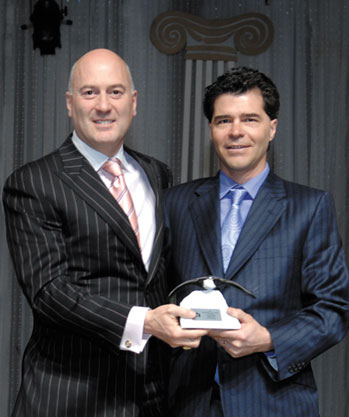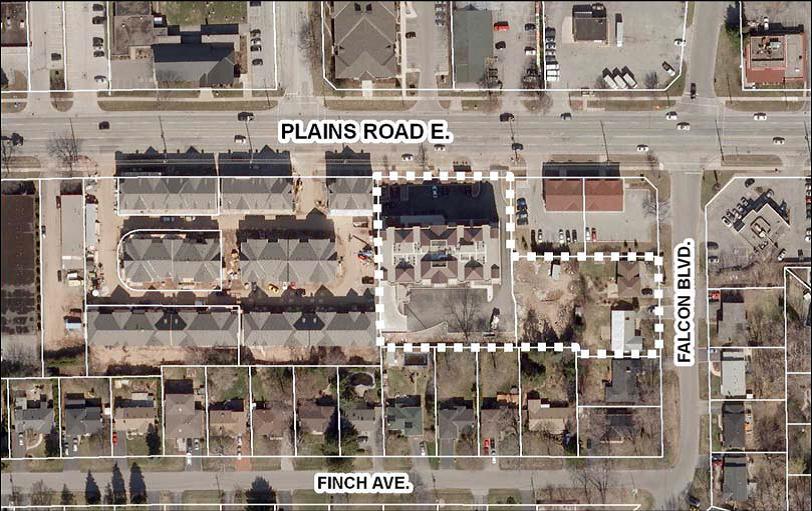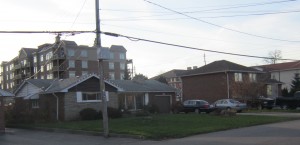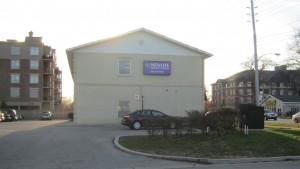BURLINGTON, ON November 24, 2011 The good folks in Aldershot were before a council committee last week asking that a zoning by-law change not be given to New Horizon Homes who want to proceed with Phase two of their development on Plains Road West at Falcon Boulevard.
Here was the issue as set out by planner Silvina Kade who gave a brief overview of the application to amend the Official Plan and Zoning By-Law 2020 for lands at 980 and 986 Falcon Boulevard and 396 and 410 Plains Road East by New Horizon Homes.
The applicant, said the planner, has purchased two single-family dwellings facing onto Falcon Boulevard in order to build a four storey residential building. Several neighborhood meetings have been held over the last four years and some area residents are unhappy with the application and the location of the proposed site.
The neighbours saw the changes the developer was asking for as a precedent that would be used to significantly change the community and they wanted none of it. For the most part Aldershot people attending the committee meeting behaved well, no noise – they just quietly make their case and depend on the council member to defend their interests.

Developers Jeff Paikin and Joe Giacomodonato with an award for best something. They aren't being seen as the best developer for a property at the intersection of Plains Road East and Falcon Blvd.
Jeff Paikin, chief cheese of New Horizon Homes, who got himself in the news earlier in the month for bulldozing what were believed to be close to the last of the fruit trees in the Orchard community. A pair of upset neighbours managed to get their picture on the front page of a local newspaper pointing to the trees that were ripped out of the ground. A bit of a kafuffle followed with the council member for the area getting involved. That issue seemed to be resolved but it did suggest the developer had lost touch with the community he was building in. Good developers maintain good relationships with the neighbourhoods they build in. Paikin is now back at Council with a project that does have its problems.
Basically the developer was not able to assemble the land he had hoped to pull together and was left unable to use the lot on the south west corner of the Plains Road West and Falcon Blvd. intersection. He had purchased two bungalows south of Plains Road and had come up with several approaches to putting up the second four story building of what he is calling the Westwood Development.
To do so – he was going to demolish the two bungalows and build a structure that would have three levels facing Falcon Blvd that would rise to four levels at the back with parking for a number of cars in front of the building. It was an imaginative solution to the problem – but the residents didn’t think it should be allowed to take place.
The owner of the property at the intersection didn’t want to sell and couldn’t be persuaded to do so even with intervention from the ward councillor Rick Craven. Does a developers inability to complete a land assembly have to result in a less than acceptable development? It’s a question that is fairly asked. That intersection can and should be developed but the owner doesn’t want to sell – which should get translated into – no development.

The white dots outline the area the residents are concerned about. The piece of land in the upper right within the dots is what gave Jeff Paikin 'heart-burn' when he wasn't able to purchase the property as part of his assembly. The result is a development that is not really in the best interest of the community but is legal.
The local residents felt that if the city went along with the changes being requested then every street running south of Plains Road would become part of a development application which would eventually work down to the lake – and they wanted none of it. Bruce Krushelniki explained that the building of the structure the developer wants to put up would not become a precedent and he explained that: “Each development application is considered on its merits based on the policy context, unique site characteristics and details of the development proposal. It is staff’s opinion that 980 & 986 Falcon Blvd. can be distinguished from most other R2.1 zoned properties in South Aldershot. This is because assembled with the adjacent Plains Rd. properties they have direct access to an arterial road on a site served by efficient peak period transit, and if approved, would result in a consistent depth of the mixed use corridor along this segment of Plains Road. The majority of the Residential Low-Density lands in South Aldershot would not satisfy the criteria of the mixed use corridor designation.
Speaker after speaker spoke of the “precedent” that would be set. More than a handful lined up politely at the podium and spoke their piece.

New Horizon Development bought the two bungalows as part of a land assembly that was to include the corner lot at the street intersection. Owner didn't want to sell - result, a rather awkward development with a low rise commercial building that will be orphaned. In the background is phase 1 of the development. Parking for both phases is underground.
Murray Thompson, 885 Falcon Boulevard, spoke in opposition to this application. He indicated that the residents in the area where not made aware of the plans for this development until 2010. Mr. Thompson stated that he believed this outcome would set a precedent for future developments of this nature.
Bill Paynter, 967 Falcon Boulevard, spoke in opposition to the development plans. He stated that the number of attendees at the neighborhood meetings was an indication of the opposition for this development. He encouraged Council to consider the level of opposition when this application is presented to Council for approval.

Two storey commercial building on land that could not be assembled - owner didn't want to sell, which was their right.
Ann Cook Petz, 819 Forest Glen Avenue, spoke on the importance of maintaining the integrity of the single-family environment of Aldershot. Ms Petz questioned if this development crossed the border of mixed use by coming down off of Plains Road. She indicated concern for preservation of the community and noted that the 1997 Plan for the area should be considered. Ms. Petz wished Council the best when determining the solution for this area, but noted that she felt that this development would be setting a precedent for the area.
Manuel Bastos, 369 Finch Avenue, spoke in opposition to the application. Bastos encouraged the City not to be anti-development but was concerned with where development occurred. He indicated that this development would destroy the character of the community. He encouraged development on Plains Road that would not face onto a residential street.
Murray Charlton, 974 Glen Acres Court, stated the developer had put a nice design together, but that it was unfortunate that the development affected a residential area. He expressed concern with the setting of a precedent, the future development in the area and how other developers could then do the same in different neighborhoods.
Teresa Ferguson, 981 Falcon Boulevard, spoke in opposition to the development. She advised the Committee that she was the homeowner directly across the street from the two residential properties purchased for development. Ferguson stated that she believed that as a taxpayers, property owners in Burlington were entitled to the same consideration as the developers. She indicated residents might have shown greater opposition had they known that the Mixed Use Corridor was intended to go beyond Plains Road.
Roland Salmon, 936 Falcon Boulevard, spoke in opposition to the development application. Salmon thanked Councillor Craven for his consistent communication to the residents. He indicated that the traffic in the community was horrible, lacked policing and that people travelled at excessive speeds along the roadway. He stated that he thought the new development would compound those issues and was concerned with developers encroaching onto residential streets two or three houses at a time.
There you have it – decent people appearing before their local government asking that the development not be permitted. No one other than the planner and the developer spoke for the project.
Where does it go from here? It will probably be approved by City Council on Monday because the city needs to do as much infill development as it can to meet the provincial Places to Grow mandate that requires Burlington to add a mix of office space and residential housing units in the next 20 years.
The province has a Public Policy Statement that requires:
Settlement areas as the focus of growth, supports development within settlement areas based on densities and a land use mix that efficiently use land, resources, infrastructure and public service facilities, and directs that opportunities for intensification and redevelopment be identified and promoted where this can be accommodated. It further supports promotion of development standards “which facilitate intensification, redevelopment and compact form, while maintaining
appropriate levels of public health and safety” and directs planning authorities to “establish and implement minimum targets for intensification and redevelopment within built-up area.
Add to that the provincial Places to Grow mandate that requires Burlington to manage Population and Employment Growth will be accommodated by
a) directing a significant portion of the new growth to the built-up areas of the community through intensification
b) focusing intensification in intensification areas
d) reducing dependence on the automobile through the development of
mixed-use, transit-supportive, pedestrian-friendly urban environments
The Plan further requires that by 2015, at least 40% of all residential development occurring annually shall be within the built-up area.
Tough for any community to overcome that kind of a requirement – is it good for the community? Can the city do anything to challenge these requirements?
Developers use this provincial requirement to persuade planners and city council that they should get the By-law and zoning change they want. Is it good planning? It is legal. Is it good community building? The residents don’t think so.
And if the zoning change is given – what happens to that lot at the intersection of Falcon Blvd. and Plains Road? It becomes an orphan. Good planning and good community building would dictate that the zoning change be denied and that people wait it out until the owner of the lot at the intersection is ready to sell. Will we do that? Probably not.



















